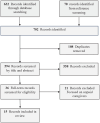Reducing the Burdens of Paid Caregivers of Older Adults by Using Assistive Technology: A Scoping Review
- PMID: 38420931
- PMCID: PMC10955782
- DOI: 10.1177/01939459241234233
Reducing the Burdens of Paid Caregivers of Older Adults by Using Assistive Technology: A Scoping Review
Abstract
Background: Paid caregivers are needed to support older adults, but caregiver burden contributes to high turnover rates. Assistive technologies help perform activities of daily living (ADLs) and can reduce caregiver burden, but little is known about how they impact paid caregivers.
Objective: This scoping review provides an overview of evidence on using assistive technology to reduce burdens on paid caregivers working with older adults.
Design: The review was conducted from May to August 2022. The eligibility criteria included: (1) publication within 5 years in peer-reviewed journals, (2) investigation of assistive technology, (3) main participants include paid caregivers supporting older adults, and (4) describing impacts on caregiver burden. Searches were conducted in 6 databases, generating 702 articles. The charted data included (1) country of study, (2) participant care roles, (3) study design, (4) main outcomes, and (5) types of assistive technology. Numerical description and qualitative content analysis of themes were used.
Results: Fifteen articles reporting on studies in 9 countries were retained for analysis. Studies used a variety of quantitative (8/15), qualitative (5/15), and mixed (2/15) methods. Technologies studied included grab bars and handrails, bidet seats, bed transfer devices, sensor and monitoring systems, social communication systems, and companion robots. Articles identified benefits for reducing stress and workload, while paid caregivers described both positive and negative impacts.
Conclusions: Literature describing the impact of assistive technology on paid caregivers who work with older adults is limited and uses varied methodologies. Additional research is needed to enable rigorous evaluation of specific technologies and impacts on worker turnover.
Keywords: assistive technology; healthcare; paid caregivers; personal support workers.
Conflict of interest statement
Declaration of Conflicting InterestsThe author(s) declared no potential conflicts of interest with respect to the research, authorship, and/or publication of this article.
Figures
Similar articles
-
Effect of a tailored assistive technology intervention on older adults and their family caregiver: a pragmatic study protocol.BMC Geriatr. 2016 May 13;16:103. doi: 10.1186/s12877-016-0269-3. BMC Geriatr. 2016. PMID: 27177609 Free PMC article. Clinical Trial.
-
Assistive technology and telecare to maintain independent living at home for people with dementia: the ATTILA RCT.Health Technol Assess. 2021 Mar;25(19):1-156. doi: 10.3310/hta25190. Health Technol Assess. 2021. PMID: 33755548 Free PMC article. Clinical Trial.
-
Assistive technologies that support social interaction in long-term care homes: a scoping review.JBI Evid Synth. 2021 Oct;19(10):2695-2738. doi: 10.11124/JBIES-20-00264. JBI Evid Synth. 2021. PMID: 34264899
-
Assistive robots to improve the independent living of older persons: results from a needs study.Disabil Rehabil Assist Technol. 2021 Jan;16(1):92-102. doi: 10.1080/17483107.2019.1642392. Epub 2019 Jul 22. Disabil Rehabil Assist Technol. 2021. PMID: 31329000
-
The impact of technology use for care by informal female caregivers on their well-being: a scoping review.Syst Rev. 2025 Apr 17;14(1):89. doi: 10.1186/s13643-025-02817-z. Syst Rev. 2025. PMID: 40241162 Free PMC article.
Cited by
-
Caregiving burdens of task time and task difficulty among paid and unpaid caregivers of persons living with dementia.Front Public Health. 2025 Jul 9;13:1615187. doi: 10.3389/fpubh.2025.1615187. eCollection 2025. Front Public Health. 2025. PMID: 40703190 Free PMC article.
-
Editorial: Assistive and service robots for health and home applications (RH3 - Robot Helpers in Health and Home).Front Neurorobot. 2024 Oct 29;18:1503038. doi: 10.3389/fnbot.2024.1503038. eCollection 2024. Front Neurorobot. 2024. PMID: 39534699 Free PMC article. No abstract available.
-
Building trust in long-term care settings using assistive technology: a systematic review.Front Rehabil Sci. 2024 Nov 22;5:1492104. doi: 10.3389/fresc.2024.1492104. eCollection 2024. Front Rehabil Sci. 2024. PMID: 39649373 Free PMC article.
References
-
- World Health Organization. Ageing and health. Accessed August 5, 2023. https://www.who.int/news-room/fact-sheets/detail/ageing-and-health
-
- Organisation for Economic Co-Operation and Development. Who Cares? Attracting and Retaining Care Workers for the Elderly. OECD Publications; 2020.
-
- Global Coalition on Aging, Home Instead. Building the caregiving workforce our aging world needs. Accessed November 29, 2023. https://globalcoalitiononaging.com/wp-content/uploads/2021/06/GCOA_HI_Bu...
Publication types
MeSH terms
LinkOut - more resources
Full Text Sources
Medical


